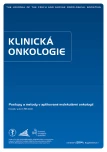Protein Expression and Purification
Authors:
E. Růčková; P. Müller; B. Vojtěšek
Authors‘ workplace:
Regionální centrum aplikované molekulární onkologie, Masarykův onkologický ústav, Brno
Published in:
Klin Onkol 2014; 27(Supplementum): 92-97
Overview
Production of recombinant proteins is essential for many applications in both basic research and also in medicine, where recombinant proteins are used as pharmaceuticals. This review summarizes procedures involved in recombinant protein expression and purification, including molecular cloning of target genes into expression vectors, selection of the appropriate expression system, and protein purification techniques. Recombinant DNA technology allows protein engineering to modify protein stability, activity and function or to facilitate protein purification by affinity tag fusions. A wide range of cloning systems enabling fast and effective design of expression vectors is currently available. A first choice of protein expression system is usually the bacteria Escherichia coli. The main advantages of this prokaryotic expression system are low cost and simplicity; on the other hand this system is often unsuitable for production of complex mammalian proteins. Protein expression mediated by eukaryotic cells (yeast, insect and mammalian cells) usually produces properly folded and posttranslationally modified proteins. However, cultivation of insect and, especially, mammalian cells is time consuming and expensive. Affinity tagged recombinant proteins are purified efficiently using affinity chromatography. An affinity tag is a protein or peptide that mediates specific binding to a chromatography column, unbound proteins are removed during a washing step and pure protein is subsequently eluted.
Key words:
recombinant protein – molecular cloning – purification – expression system
This work was supported by the European Regional Development Fund and the State Budget of the Czech Republic (RECAMO, CZ.1.05/ 2.1.00/ 03.0101) and by MH CZ – DRO (MMCI, 00209805).
The authors declare they have no potential conflicts of interest concerning drugs, products, or services used in the study.
The Editorial Board declares that the manuscript met the ICMJE “uniform requirements” for biomedical papers.
Submitted:
22. 1. 2014
Accepted:
20. 3. 2014
Sources
1. Porath J, Flodin P. Gel filtration: a method for desalting and group separation. Nature 1959; 183(4676): 1657– 1659.
2. Raymond S, Weintraub L. Acrylamide gel as a supporting medium for zone electrophoresis. Science 1959; 130(3377): 711.
3. Curtain CC. Chromatography of proteins and peptides on diethylaminoethyl methacrylate gels. Anal Biochem 1963; 6: 512– 519.
4. Hjerten S. The preparation of agarose spheres for chromatography of molecules and particles. Biochim Biophys Acta 1964; 79: 393– 398.
5. Weetall HH. Preparation and characterization of an arylsulphatase insolubilized on porous glass. Nature 1971; 232(5311): 473– 474.
6. Axén R, Porath J, Ernback S. Chemical coupling of peptides and proteins to polysaccharides by means of cyanogen halides. Nature 1967; 214(5095): 1302– 1304.
7. Jackson DA, Symons RH, Berg P. Biochemical method for inserting new genetic information into DNA of Simian Virus 40: circular SV40 DNA molecules containing lambda phage genes and the galactose operon of Escherichia coli. Proc Natl Acad Sci USA 1972; 69(10): 2904– 2909.
8. Lobban PE, Kaiser AD. Enzymatic end‑to end joining of DNA molecules. J Mol Biol 1973; 78(3): 453– 471.
9. Cohen SN, Chang AC, Boyer HW et al. Construction of biologically functional bacterial plasmids in vitro. Proc Natl Acad Sci USA 1973; 70(11): 3240– 3244.
10. Landy A. Dynamic, structural, and regulatory aspects of lambda site‑ specific recombination. Annu Rev Biochem 1989; 58: 913– 949.
11. Wacker M, Linton D, Hitchen PG et al. N‑linked glycosylation in Campylobacter jejuni and its functional transfer into E. coli. Science 2002; 298(5599): 1790– 1793.
12. Valderrama‑Rincon JD, Fisher AC, Merritt JH et al. An engineered eukaryotic protein glycosylation pathway in Escherichia coli. Nat Chem Biol 2012; 8(5): 434– 436. doi: 10.1038/ nchembio.921.
13. Berkner KL. Expression of heterologous sequences in adenoviral vectors. Curr Top Microbiol Immunol 1992; 158: 39– 66.
14. Graham FL, Smiley J, Russell WC et al. Characteristics of a human cell line transformed by DNA from human adenovirus type 5. J Gen Virol 1977; 36(1): 59– 74.
15. Stephenson JR, Khan AS, van de Ven WJ et al. Type Cretroviruses as vectors for cloning cellular genes with probable transforming function. J Natl Cancer Inst 1979; 63(5): 1111– 1119.
16. Cavazzana‑ Calvo M, Hacein‑Bey S, de Saint Basile G et al. Gene therapy of human severe combined immunodeficiency (SCID)- X1 disease. Science 2000; 288(5466): 669– 672.
17. Smith DB, Johnson KS. Single‑step purification of polypeptides expressed in Escherichia coli as fusions with glutathione S‑ transferase. Gene 1988; 67(1): 31– 40.
18. Hochuli E. Purification of recombinant proteins with metal chelate adsorbent. Genet Eng (NY) 1990; 12: 87– 98.
19. Schmidt TG, Skerra A. One‑ step affinity purification of bacterially produced proteins by means of the “Strep tag” and immobilized recombinant core streptavidin. J Chromatogr A 1994; 676(2): 337– 345.
20. Keefe AD, Wilson DS, Seelig B et al. One‑ step purification of recombinant proteins using a nanomolar‑ affinity streptavidin‑binding peptide, the SBP‑ Tag. Protein Expr Purif 2001; 23(3): 440– 446.
21. Chen GQ, Gouaux JE. Overexpression of bacterio‑ opsin in Escherichia coli as a water‑ soluble fusion to maltose binding protein: efficient regeneration of the fusion protein and selective cleavage with trypsin. Protein Sci 1996; 5(3): 456– 467.
22. Braun P, LaBaer J. High throughput protein production for functional proteomics. Trends Biotechnol 2003; 21(9): 383– 388.
23. Köhler G, Milstein C. Continuous cultures of fused cells secreting antibody of predefined specificity. Nature 1975; 256(5517): 495– 497.
24. Hunt I. From gene to protein: a review of new and enabling technologies for multi‑parallel protein expression. Protein Expr Purif 2005; 40(1): 1– 22.
Labels
Paediatric clinical oncology Surgery Clinical oncologyArticle was published in
Clinical Oncology

2014 Issue Supplementum
Most read in this issue
- Protein Expression and Purification
- Methods for Studying Tumor Cell Migration and Invasiveness
- Next Generation Sequencing – Application in Clinical Practice
- Analysis of Protein Using Mass Spectrometry
